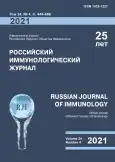Particular features of humoral immunity in patients with acute brain concussion
- 作者: Norka A.O.1,2, Vorobyev S.V.3,4, Kuznetsova R.N.1,5, Serebriakova M.K.6, Kudryavtsev I.V.6,1, Kovalenko S.N.7
-
隶属关系:
- First St. Petersburg State I. Pavlov Medical University
- St. Petersburg State Pediatric Medical University,
- V. Almazov National Medical Research Centre
- State Pediatric Medical University
- St. Petersburg Pasteur Research Institute of Epidemiology and Microbiology
- Institute of Experimental Medicine
- S. Kirov Military Medical Academy
- 期: 卷 24, 编号 4 (2021)
- 页面: 525-530
- 栏目: SHORT COMMUNICATIONS
- URL: https://journals.rcsi.science/1028-7221/article/view/120198
- DOI: https://doi.org/10.46235/1028-7221-1049-PFO
- ID: 120198
如何引用文章
全文:
详细
Traumatic brain injury (TBI) is one of the most common neurological disorders in the world. Meanwhile, usage of neuroimaging methods does not allow precise assessment of its severity and clinical prognosis. This predetermines for searching new techniques of differential diagnosis of the TBI severity and predicting the risk of consequences. Currently, many authors have shown an association between disorders of the immune system manifesting as a decrease in general immune status, and development of cellular/humoral neurosensitization with progredient outcome of the brain injury. At the same time, the role of humoral mechanisms in pathogenesis of TBI, in particular, brain commotion, is less studied in comparison with cell-mediated mechanisms, thus suggesting a need to studying the role of activation or, vice versa, anergy of the humoral immunity in mild traumatic brain injury. The aim of this work was to study characteristics of B-lymphocyte subpopulations in peripheral blood of the patients with brain concussion (n = 22). Peripheral blood samples obtained from 52 apparently healthy volunteers served as controls. The diagnosis was made in accordance with established international criteria. In this case, the exclusion criterion were as follows: severe concomitant organ damage or somatic pathologies, as well as presence of intoxication. General examination included the collection of complaints, medical history, assessment of the somatic and neurological status. B-lymphocytes were determined using multicolor flow cytometry based on two approaches: IgD/CD38 expression (“Bm1-Bm5” classification), and IgD/CD27. We have found that the relative number of naïve Bm1 (IgD+CD38-) was significantly higher in patients with brain concussion than in conventionally healthy individuals (p < 0.001). The relative content of activated naive Bm2-cells (IgD+CD38+) was significantly lower in the group of TBI patients than in controls (p < 0.05). The number of naive cells (IgD+CD27-) was also significantly reduced in the brain concussion group compared to the control group. The data obtained indicate a possible significant role of B-cell immune response in pathogenesis of clinical course following the brain concussion, thus enabling assessment of possible features of humoral immune response.
作者简介
A. Norka
First St. Petersburg State I. Pavlov Medical University;St. Petersburg State Pediatric Medical University,
编辑信件的主要联系方式.
Email: norka-anna@mail.ru
Senior Laboratory Assistant, Department of Immunology; Resident, Department of Neonatology with courses of Neurology and Obstetrics/Gynecology
St. Petersburg
俄罗斯联邦S. Vorobyev
V. Almazov National Medical Research Centre;State Pediatric Medical University
PhD, MD (Medicine), Chief Research Associate, Research Laboratory of Neurology and Neurorehabilitation; Professor, Department of Clinical Laboratory Diagnostics
St. Petersburg
俄罗斯联邦R. Kuznetsova
First St. Petersburg State I. Pavlov Medical University;St. Petersburg Pasteur Research Institute of Epidemiology and Microbiology
PhD (Medicine), Associate Professor, Department of Immunology; Allergist-Immunologist, Medical Centre
St. Petersburg
俄罗斯联邦M. Serebriakova
Institute of Experimental Medicine
Postgraduate Student, Research Associate, Department of Immunology
St. Petersburg
俄罗斯联邦I. Kudryavtsev
Institute of Experimental Medicine;First St. Petersburg State I. Pavlov Medical University
PhD (Biology), Senior Research Associate, Department of Immunology; Associate Professor, Department of Immunology
St. Petersburg
俄罗斯联邦S. Kovalenko
S. Kirov Military Medical Academy
Lecturer, Department of Neurosurgery
St. Petersburg
俄罗斯联邦参考
- Будкова А.И., Лапин С.В., Серебрякова М.К., Кудрявцев И.В., Тришина И.Н., Маслянский А.Л., Тотолян А.А. Субпопуляционный состав В-клеток периферической крови у больных системной красной волчанкой // Медицинская иммунология, 2017. Т. 19, № 2. С. 175-184. doi: 10.15789/1563-0625-2017-2-175-184.
- Лихтерман Л.Б. Черепно-мозговая травма. Диагностика и лечение. М.: ГЭОТАР-Медиа, 2014. 488 с.
- Потапов А.А., Лихтерман Л.Б., Кравчук А.Д., Корниенко В.Н., Захарова Н.Е., Ошоров А.В., Филатова М.М. Современные подходы к изучению и лечению черепно-мозговой травмы // Анналы клинической и экспериментальной неврологии, 2010. Т. 4, № 1. С. 4-12.
- Хайдуков С.В., Байдун Л.А., Зурочка А.В., Тотолян Арег А. Стандартизованная технология «Исследование субпопуляционного состава лимфоцитов периферической крови с применением проточных цитофлюориметров-анализаторов» (проект) // Медицинская иммунология, 2012. Т. 14, № 3. С. 255-268. doi: 10.15789/1563-0625-2012-3-255-268.
- Bergold P.J. Treatment of traumatic brain injury with anti-inflammatory drugs. Exp. Neurol., 2016, Vol. 275, Pt. 3, pp. 367-380.
- Burda J.E., Sofroniew M.V. Reactive gliosis and the multicellular response to CNS damage and disease. Neuron, 2014, Vol. 81, no. 2, pp. 229-248.
- Dewan M.C., Rattani A., Gupta S., Baticulon R.E., Hung Y.C., Punchak M., Agrawal A., Adeleye A.O., Shrime M.G., Rubiano A.M., Rosenfeld J.V., Park K.B. Estimating the global incidence of traumatic brain injury. J. Neurosurg., 2018, pp. 1-18.
- Fehily B., Fitzgerald M. Repeated mild traumatic brain injury: potential mechanisms of damage. Cell Transplant., 2017, Vol. 26, no. 7, pp. 1131-1155.
- Jarrahi A., Braun M., Ahluwalia M., Gupta R.V., Wilson M., Munie S. Revisiting traumatic brain injury: from molecular mechanisms to therapeutic interventions. Biomedicines, 2020, Vol. 8, 389. doi: 10.3390/biomedicines8100389.
- Simon D.W., McGeachy M.J., Bayır H., Clark R.S., Loane D.J., Kochanek P.M. The far-reaching scope of neuroinflammation after traumatic brain injury. Nat. Rev. Neurol., 2017, Vol. 13, no. 3, pp. 171-191.
- Schwartz M., Raposo C. Protective autoimmunity: a unifying model for the immune network involved in CNS repair. Neuroscientist, 2014, Vol. 20, no. 4, pp. 343-358.
补充文件







